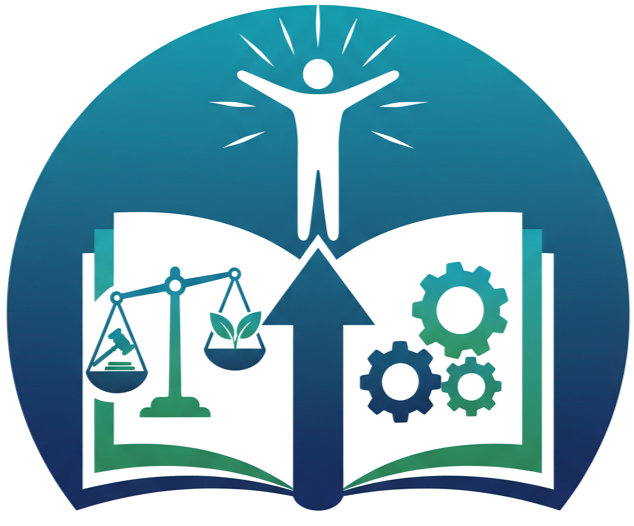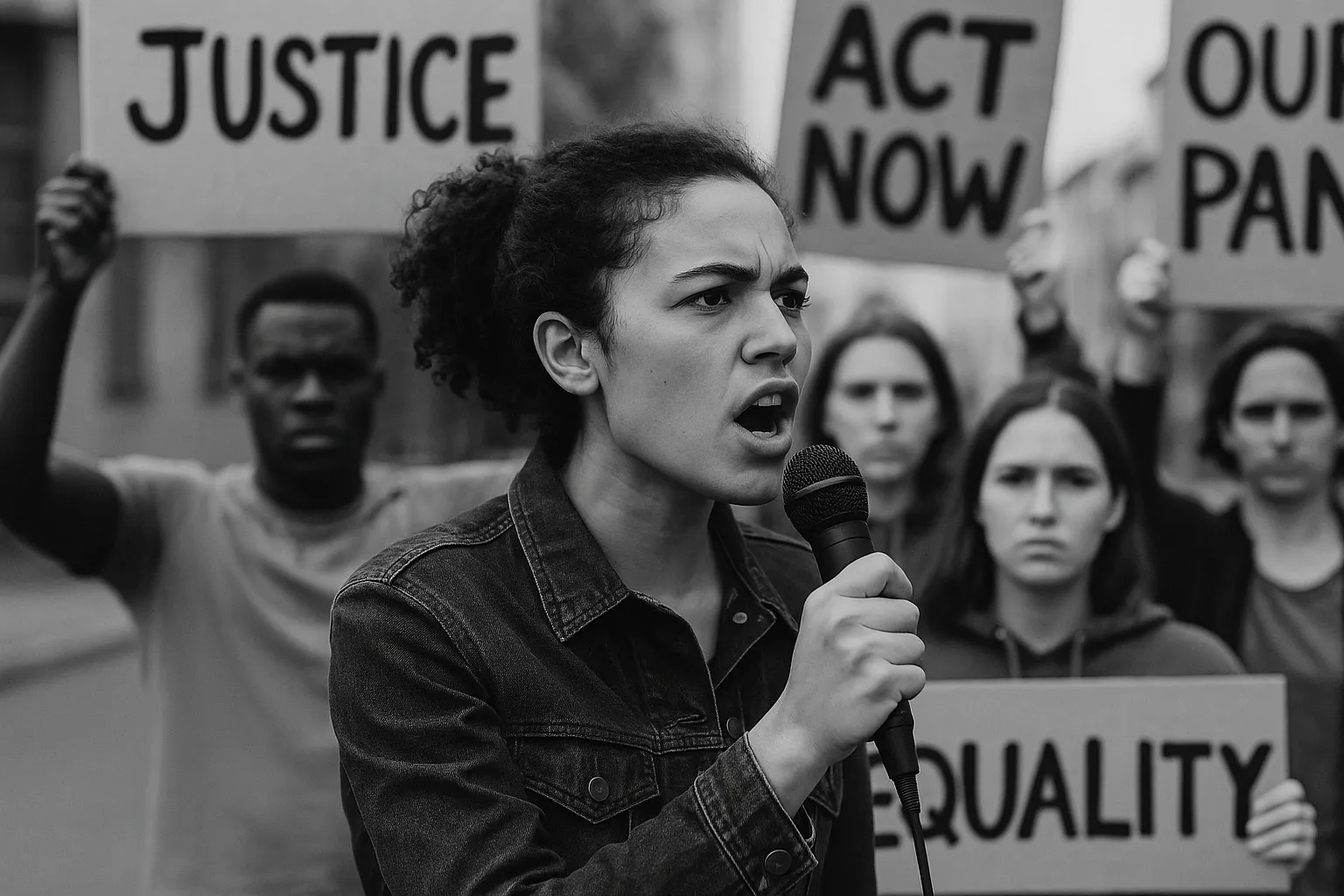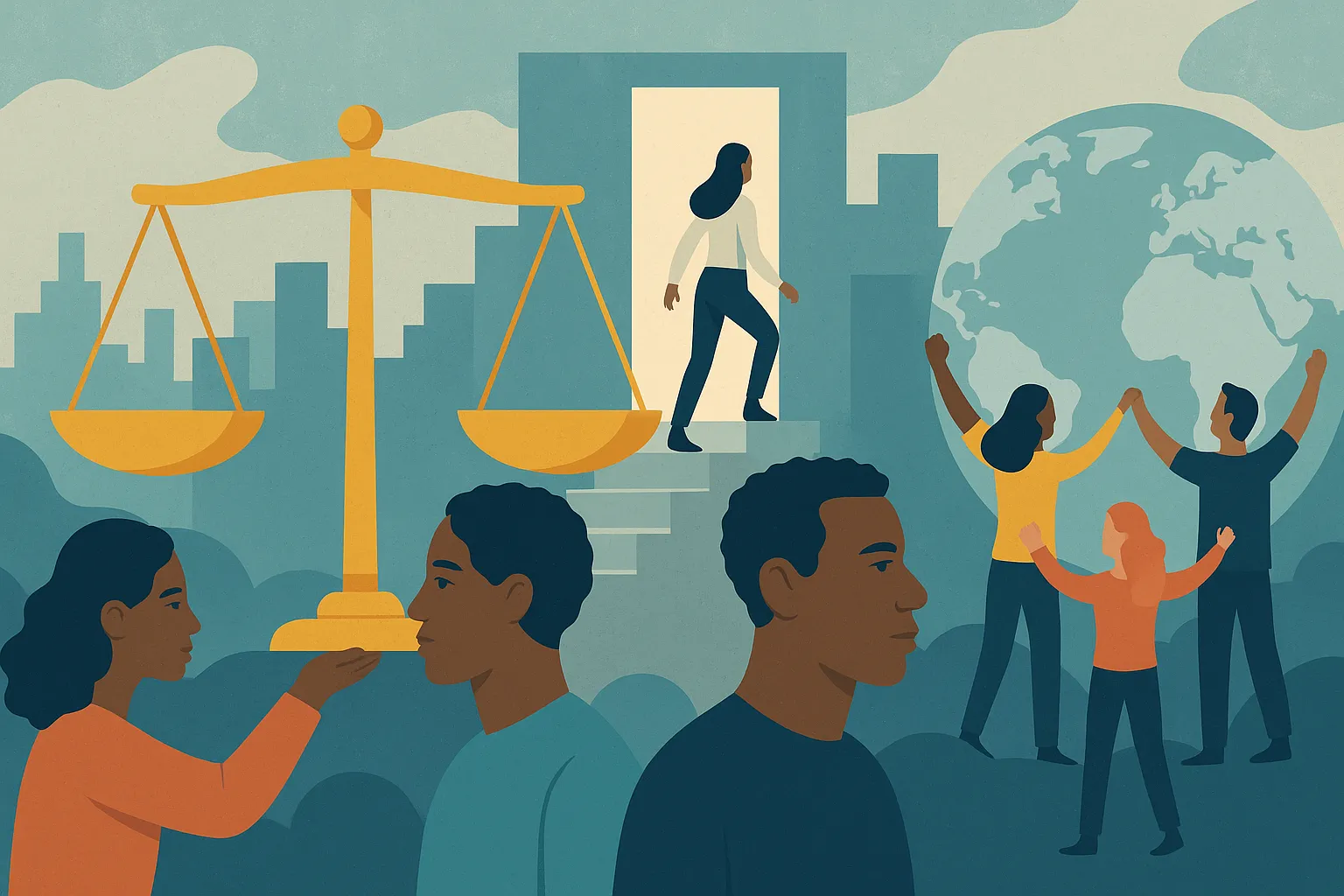The Power of a Single Voice
Throughout history, every great movement for justice and equality has begun with a single voice — someone who refused to stay silent in the face of wrongdoing. From civil rights to Indigenous advocacy, from gender equality to environmental justice, the pattern remains the same: one person speaks up, others listen, and the truth begins to spread. What starts as a whisper of dissent becomes a call for transformation.
The importance of these voices lies not only in their courage but in their humanity. They remind society that progress is not abstract — it is personal. Behind every policy reform or institutional shift is a story of someone who suffered, resisted, or envisioned something better. These stories carry moral weight because they reveal the lived experience behind systemic injustice. They make statistics human and injustice visible.
Change often feels impossible until a single voice makes it real. When one person dares to speak the truth, it creates space for others to follow. This ripple effect — from individual to collective — is what turns pain into power.
Breaking the Silence
Silence is often the most powerful ally of injustice. Institutions, by nature, seek stability, and speaking out threatens that stability. Many who witness wrongdoing are pressured to stay quiet — by fear, by shame, or by a belief that their voice won’t matter. Yet history proves the opposite. Every breakthrough in human rights, from the abolition of slavery to the recognition of Indigenous sovereignty, began with people who refused to be silent.
Breaking silence is an act of defiance, but it is also an act of hope. It represents the belief that truth, once spoken, has the power to challenge even the most entrenched systems. When victims of abuse, discrimination, or neglect share their stories publicly, they do more than seek justice for themselves — they invite society to see what it has ignored.
The process of speaking out is rarely easy. It requires strength to confront authority, to revisit trauma, and to risk being disbelieved. Yet, every time someone speaks, the wall of denial weakens a little more. Over time, collective truth-telling becomes impossible to dismiss.
The Role of Public Testimony
Public inquiries, truth commissions, and community hearings provide structured platforms where these voices can be heard and recorded. They transform personal testimony into public memory, ensuring that individual suffering becomes part of a collective understanding.
Public testimony is not only a legal exercise but an emotional and cultural one. It allows people to reclaim their narrative from the institutions that wronged them. For many survivors, simply being listened to — without judgment or dismissal — is a step toward healing. It acknowledges their dignity and validates their pain.
At the same time, testimony serves as evidence. It shapes how history will be written and how future generations will understand the struggles of their time. When documented truthfully and preserved with respect, these voices form the foundation for reform. They influence policy, change laws, and remind decision-makers that their actions have human consequences.
In this way, public testimony becomes both a personal act of liberation and a civic act of responsibility — one that transforms silence into a force for justice.
From Personal Story to Collective Movement
While one voice can spark awareness, collective voices sustain change. When individual experiences connect through shared struggle, they form a movement — a network of people united not by power but by purpose.
Collective movements amplify stories that might otherwise be ignored. They create visibility for those who have been marginalized and turn personal injustice into a societal issue. The civil rights movement, for example, was built on countless individual acts of courage — students refusing segregation, workers striking for fair pay, and communities marching for equality. Each action, taken alone, might have seemed small. Together, they reshaped history.
This collective power remains essential in modern times. Whether it’s Indigenous activists demanding land rights, women speaking out against violence, or youth leading climate protests, change emerges when voices converge around a shared demand for dignity and accountability.
These movements also reveal a deeper truth: systemic problems cannot be solved in isolation. They require solidarity — the understanding that one person’s injustice diminishes everyone’s freedom. When society listens collectively, it begins to heal collectively.
The Courage to Speak Truth to Power
Challenging authority is one of the most difficult and dangerous forms of truth-telling. Whistleblowers, journalists, and activists who expose corruption or abuse often face retaliation. They are dismissed, threatened, or discredited. Yet without them, the machinery of injustice would continue unchallenged.
Speaking truth to power is an act of moral clarity. It demands that individuals prioritize conscience over comfort. These voices remind us that justice is not achieved through silence or neutrality but through courage.
In democratic societies, protecting such voices is vital. Legal frameworks must safeguard freedom of speech, independent journalism, and the right to protest. Without these protections, truth becomes a privilege rather than a right.
The strength of a society’s democracy can often be measured by how it treats its truth-tellers. When their voices are respected, society grows stronger. When they are silenced, corruption and apathy take root.
The Emotional Weight of Change
Behind every voice that inspires change is an emotional journey — fear, pain, loss, but also resilience and hope. Speaking out is not just an intellectual act; it is deeply human. It requires confronting trauma and vulnerability while believing that words can build something better.
Communities that have suffered collective harm — such as Indigenous peoples, survivors of war, or victims of institutional neglect — carry memories that must be spoken before healing can occur. When those stories are shared publicly, they not only reclaim identity but also transform grief into collective strength.
This process can be uncomfortable for society at large. Listening to truth requires humility. It forces people to acknowledge complicity, ignorance, or privilege. But this discomfort is necessary. True change never comes from comfort — it comes from confronting what is difficult to hear.
When communities and governments are willing to listen with empathy rather than defensiveness, they create the conditions for reconciliation and progress.
Representation and Empowerment
Representation is another form of voice. When people from marginalized backgrounds see themselves reflected in positions of influence — in government, media, or leadership — they begin to believe that their experiences matter.
Empowerment through representation ensures that policy is informed by lived experience, not detached authority. A justice system shaped by diverse voices is more likely to serve everyone fairly. The inclusion of Indigenous leaders, women, and minority communities in public discussions transforms institutions from the inside, making them more reflective of the societies they govern.
Moreover, representation creates role models. When individuals see someone like themselves breaking barriers, it signals that change is not only possible but achievable. This visibility inspires others to speak up, creating a continuous cycle of empowerment that strengthens democracy.
The Ripple Effect of Courage
The influence of one voice extends far beyond its initial echo. A single act of courage can inspire thousands to follow. When someone takes a stand publicly, they give others permission to do the same. This is how cultural change begins — not through sudden revolution, but through persistent waves of truth-telling that erode old systems of denial.
Each story adds to a growing archive of collective wisdom. It becomes harder for society to ignore injustice when it is spoken aloud by many. Eventually, the accumulation of truth reaches a tipping point — a moment when inaction becomes morally indefensible.
This ripple effect is what transforms individual defiance into collective conscience. Over time, those once seen as outsiders or agitators are recognized as leaders and reformers. The same society that resisted their message eventually celebrates them as symbols of progress.
From Speaking Out to Being Heard
When individuals and communities speak up against injustice, the first step toward transformation is taken — but the journey doesn’t end there. A voice alone can awaken awareness, yet real change requires that those in power listen and act. Far too often, societies celebrate bravery in hindsight but fail to respond when courage is most needed. The voices that inspire change are not meant to echo endlessly into silence; they are meant to be heard, understood, and translated into reform.
For institutions to truly hear these voices, they must cultivate empathy and humility. Listening is not a passive act — it demands openness, vulnerability, and a willingness to confront uncomfortable truths. When governments, police, or social systems genuinely listen to marginalized voices, they are forced to question long-standing assumptions and face the realities of their failures. Only then can meaningful reform take root.
In democratic societies, listening becomes a moral duty. It is how power remains connected to the people it serves. Without attentive listening, truth becomes noise, and courage becomes wasted.
Turning Testimony into Policy
Testimonies, whether spoken in inquiries, commissions, or community gatherings, hold immense transformative potential — but they must not remain symbolic. For true progress, they must inform and shape public policy.
Every voice that exposes a failing reveals a lesson. Every story that sheds light on injustice identifies a gap in law, policy, or culture. Policymakers who treat these testimonies as living evidence — not as isolated complaints — can design reforms that address root causes rather than symptoms.
Take, for example, public inquiries into institutional abuse or police misconduct. The most effective outcomes arise when governments implement clear policy changes based on what survivors and witnesses have shared — training reforms, new accountability structures, independent oversight, and community-driven initiatives. When lived experience guides legislative change, justice becomes both practical and human.
The transformation from testimony to policy represents a shift in power. It signals that those who once suffered in silence now have a voice in shaping the very systems that failed them. That is the essence of progress — when the voiceless become architects of reform.
Collective Listening as a Social Practice
Listening should not be limited to leaders or policymakers. Societies themselves must learn to listen collectively. Public empathy forms the cultural foundation upon which reform stands. When citizens choose to listen to one another — across lines of class, race, and experience — they build understanding that transcends division.
Collective listening takes many forms: public dialogues, community forums, truth and reconciliation commissions, or simply open conversations that replace judgment with curiosity. These spaces allow pain to be witnessed and dignity to be restored. They transform anger into action and isolation into solidarity.
The greatest societal changes occur when listening becomes a shared value — when people understand that hearing another’s story does not diminish their own. It is in listening, not argument, that we find common ground. In that sense, the voice of change belongs to everyone who chooses compassion over indifference.
Empathy as a Force for Transformation
Empathy is often dismissed as emotion, but in truth, it is a political force. Policies crafted without empathy tend to serve systems, not people. When institutions fail to consider how their decisions affect real lives, they lose sight of their purpose.
Empathy allows decision-makers to feel the weight of injustice. It compels them to act not out of obligation but out of conviction. For instance, when a policymaker hears firsthand the story of a person whose life was destroyed by systemic neglect, that experience becomes unforgettable. It shapes their understanding of fairness, duty, and humanity.
Empathy-driven leadership transforms bureaucracies into communities of care. It reminds those in authority that justice is not just a rule of law but an act of moral responsibility. Without empathy, transparency feels hollow; oversight feels mechanical. With it, reform becomes guided by compassion — the most sustainable form of accountability.
When the World Finally Listens
There are moments in history when the world collectively pauses — moments when injustice becomes impossible to ignore. These are the turning points when individual voices ignite global movements.
The civil rights marches in the United States, the Truth and Reconciliation process in South Africa, the #MeToo movement, or Indigenous land rights activism in Canada — all demonstrate how one voice, amplified through solidarity, can reshape societies. These moments do not happen overnight. They are the result of years, sometimes decades, of persistence by people who refused to be silenced.
What connects these movements is the power of moral clarity. Each one begins with a simple truth: people deserve to be treated with dignity. When that truth resonates widely enough, systems change — laws are rewritten, institutions reformed, and cultural norms challenged.
But these global moments also remind us of a critical lesson: attention is temporary unless followed by commitment. Listening must not fade once headlines move on. The true test of progress is whether the voices that inspired outrage also inspire ongoing action.
From Inspiration to Implementation
Inspiration is the spark, but implementation is the fire that sustains it. Real change demands structure — policies, resources, education, and accountability. Once society has been awakened by courageous voices, it must translate that awareness into tangible reform.
Implementation requires patience and persistence. Cultural transformation is slow, and resistance is inevitable. Yet history shows that consistent effort, even in small increments, leads to lasting impact. Schools that integrate human rights education, police forces that adopt independent review mechanisms, or governments that include marginalized communities in decision-making — all are examples of inspiration made real.
Each reform, no matter how modest, keeps the spirit of those original voices alive. Implementation ensures that their courage was not in vain.
The Role of Art, Media, and Education
Not all voices of change are spoken through speeches or hearings. Art, media, and education are powerful amplifiers of truth. They give emotional depth to facts and make distant issues personal. A documentary, a painting, or a classroom discussion can move hearts where policy debates cannot.
Artists and educators act as translators between experience and understanding. They make complex social issues accessible to those who might otherwise turn away. In doing so, they create empathy on a mass scale — transforming awareness into cultural momentum.
Independent media also play a critical role. Investigative journalists often uncover truths that spark inquiries and reform. Their persistence keeps stories alive long after official reports have concluded. When art and media echo the same moral truths spoken by victims and activists, their combined power becomes unstoppable. They remind the public that social responsibility is not only institutional — it is personal.
Healing Through Recognition
One of the most profound outcomes of giving voice to injustice is healing. Recognition — the act of being seen and heard — can restore dignity even when full justice remains elusive. For survivors of systemic neglect or abuse, acknowledgment itself can be transformative.
Healing occurs when pain is validated, when apologies are sincere, and when reforms signal that their suffering will not be repeated. For communities that have faced generational trauma, such as Indigenous peoples, recognition extends beyond individual experience — it becomes cultural revival. When history finally tells the truth, collective identity is strengthened rather than erased.
This process of healing through recognition underscores why voices must never be dismissed as emotional or anecdotal. They carry truths that statistics cannot measure — truths that guide society toward empathy, reconciliation, and unity.
Sustaining the Momentum of Change
Once a society begins to change, the challenge becomes maintaining momentum. Voices that inspire reform can easily be forgotten if systems revert to old habits or if fatigue sets in. Sustaining progress requires constant vigilance — new generations must inherit not only the stories but the responsibility to continue the work.
This is why education and remembrance are essential. Museums, archives, and public commemorations ensure that the voices of the past remain part of the present. When young people learn the names and stories of those who fought for justice, they understand that their own voices matter too. Change becomes not an event but a tradition.
The goal is to create a culture where speaking up is no longer exceptional but expected — where transparency, empathy, and courage are embedded in everyday life.
Conclusion
Voices that inspire change are the conscience of humanity. They challenge silence, confront power, and awaken the collective will to do better. Yet their true strength lies not in their volume but in their persistence — in their ability to echo across generations until justice is achieved.
Listening to these voices is both a privilege and a responsibility. It demands not only attention but action — reform that honors their courage and prevents their struggles from repeating.
Every time a story is shared, every time someone dares to speak truth to power, society takes one step closer to compassion, accountability, and equality. And every time that story becomes action — through policy, reform, or cultural awakening — the cycle of change continues.
The lesson is simple but profound: the voices that inspire change are not relics of history. They live in all of us — waiting to be heard, waiting to be believed, and waiting to be carried forward into a world that finally listens, learns, and acts.





